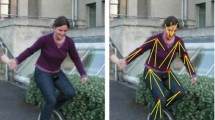Abstract
In this paper, we propose a novel method to segment human body in static images by graph cuts based on two deformable models at two-scale superpixel. In our study, body segmentation is decomposed into torso detection and lower body recovery. Based on the first-scale superpixel, the seeds of torso are obtained on the basis of the coarse torso region, which is estimated by an improved deformable torso model. For the lower body, we estimate the hip region to obtain the seeds of lower body at the second-scale superpixel. Besides, a deformable upper leg model is designed to derive more foreground seeds of the lower body. To avoid failure caused by the heavy dependence between the two hierarchies, a scheme of probabilistic hierarchical detection is presented. Experiments on our datasets containing 200 images photographed by ourselves and 100 other images collected from public datasets show that our approach can accurately segment human body in static images with a variety of poses, backgrounds and clothing. Segmenting the human body in static image based on deformable torso and upper leg models at two-scale superpixel.













Similar content being viewed by others
Notes
In our experiments, it is set to the half of the covariance of the χ 2 distances \( d_{{\chi^{2} }} (S_{i}^{t} ,T_{s} ) \).
When the estimation of the likelihood is performed, the bounding box of torso is fixed ignoring the face location, as well as the GMM of the background.
The ground truth of images derived from Berkeley and INRIA are labeled by hand. We select the images according to the face. That is, if the face in the image can be detected, we then choose this image.
We download the code from http://www.seas.upenn.edu/~timothee/software/ncut_multiscale/ncut_multiscale.html
To the best of our knowledge, there is no evaluation criterion for this. We simply count the detected limbs for comparison.
References
Boykov Y, Veksler O, Zabih R (2001) Fast approximate energy minimisation via graph cuts. IEEE Trans PAMI 23(11):1222–1239
Shi J, Malik J (2000) Normalized cuts and image segmentation. IEEE Trans PAMI 22(8):888–905
Mori G, Malik J (2002) Estimating human body configurations using shape context matching. In: European conference on computer vision. LNCS 2352, 666–680
Poppe R, Poel M (2005) Example-based pose estimation in monocular images using compact fourier descriptors. Technical report TR-CTIT-05-49, pp 1–19
Agarwal A, Triggs B (2006) A local basis representation for estimating human pose from cluttered images. ACCV, pp 50–59
Lin Z, Davis LS, Doermann D, DeMenthon D (2007) Hierarchical Part-Template Matching for Human Detection and Segmentation, ICCV
Mohan A, Papageorgiou C, Poggio T (2001) Example-based object detection in images by components. IEEE Trans PAMI 23(4):349–361
Mori G, Ren X, Efros AA, Malik J (2004) Recovering human body configurations: combining segmentation and recognition. CVPR, pp 326–333
Hu Z, Lin X, Yan H (2006) Torso Detection in Static Images. ICSP
Strinivasan P, Shi J (2007) Bottom-up recognition and parsing of the human body. CVPR
Ramanan D, Forsyth DA (2003) Finding and tracking people from the bottom up. CVPR
Lee MW, Cohen I (2004) Human upper body pose estimation in static images. ECCV
Ramanan D, Sminchisescu C (2006) Training deformable models for localization. CVPR, 206–213
Mori G (2005) Guiding model search using segmentation. ICCV, pp 1417–1423
Lee MW, Nevatia R (2007) Body part detection for human pose estimation and tracking. IEEE WMVC, pp 23–31
Hu Z, Wang G, Lin X, yan H (2009) Recovery of upper body poses in static images based on joints detection. Pattern Recog Lett 30(5):503–512
Fulkerson B, Vedaldi A, Soatto S (2009) Class segmentation and object localization with superpixel neighborhoods. ICCV, pp 670–678
Ren X, Malik J (2003) Learning a classification model for segmentation. ICCV, pp 10–17
Oliveira PR, Romero RAF (2008) Improvements on ICA mixture models for image pre-processing and segmentation. Neurocomputing 71(10-12):2180–2193
Maire M, Arbelaez P, Fowlkes C, Malik J (2008) Using contours to detect and localize junctions in natural images. CVPR, pp 1–8
Viola P, Jones M (2004) Robust real-time face detection. Int J Comput Vis 57(2):137–154
Rother C, Kolmogorov V, Blake A (2004) Grabcut: interactive foreground extraction using iterated graph cuts. ACM Trans Graph 23(3):309–314
Acknowledgment
The work was supported by the Fundamental Research Funds for the Central Universities, No. DUT10JS05, the National Natural Science Foundation of China (NSFC), No. 61071209 and Omron Corporation's grant No. DUT09001.
Author information
Authors and Affiliations
Corresponding author
Electronic supplementary material
Below is the link to the electronic supplementary material.
Rights and permissions
About this article
Cite this article
Li, S., Lu, HC., Ruan, X. et al. Human body segmentation based on deformable models and two-scale superpixel. Pattern Anal Applic 15, 399–413 (2012). https://doi.org/10.1007/s10044-011-0220-3
Received:
Accepted:
Published:
Issue Date:
DOI: https://doi.org/10.1007/s10044-011-0220-3




